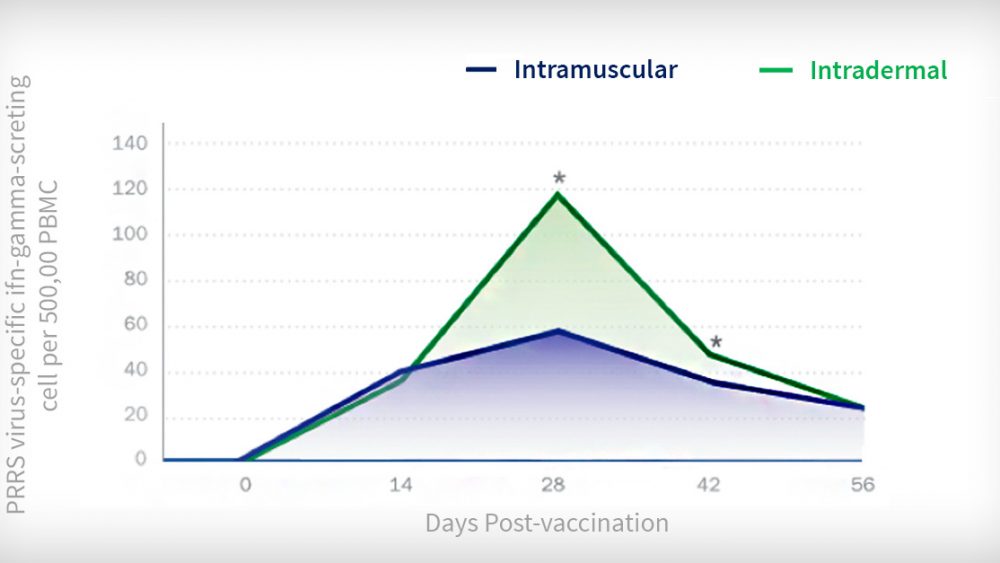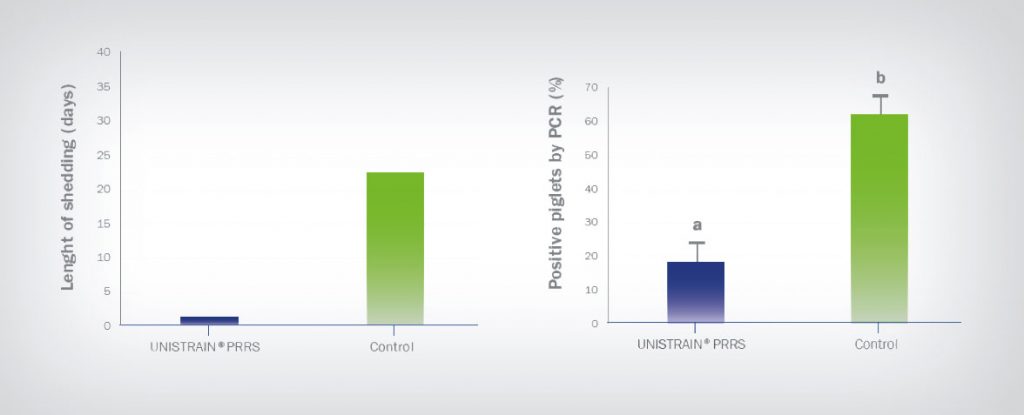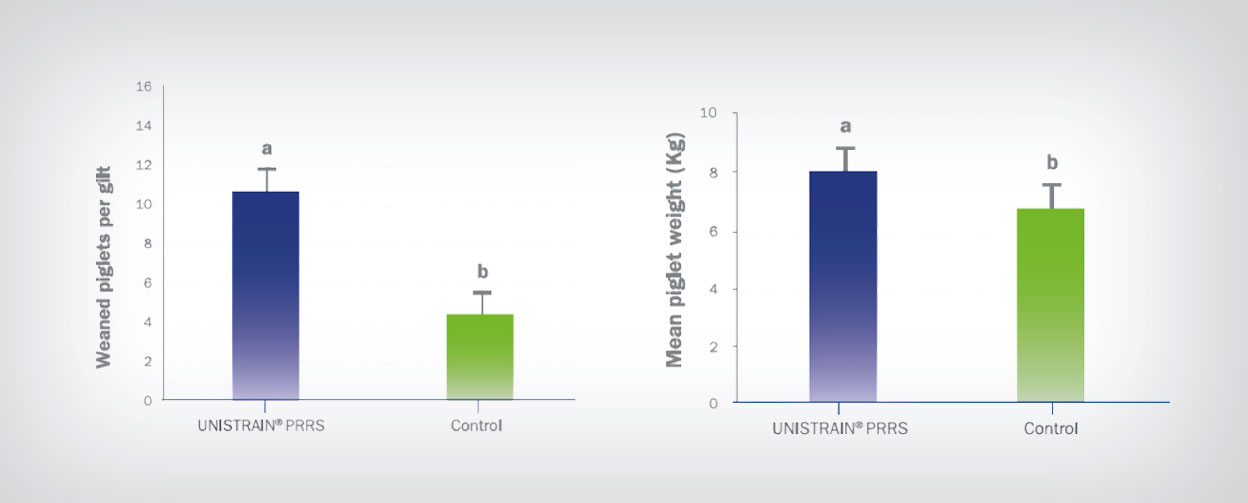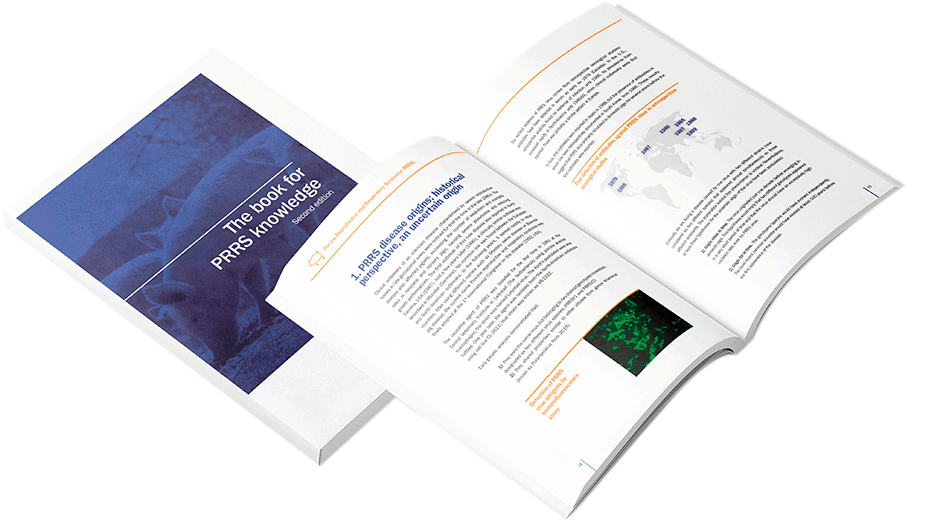Numerous strategies have been described for the control of PRRS on farms. After more than 25 years dealing with PRRS disease, most vets agree that in order to successfully control the disease a combination of the following measures is required: animal management, biosecurity, diagnosis and active immunisation.
Although vaccination does not necessarily provide full and universal protection against PRRS infection, vaccines have beneficial effects in terms of clinical and virological protection, reducing the impact of the disease.
PRRS sow vaccination: What are the benefits?
It has been demonstrated that sow vaccination is effective for reduce the number of abortions, the mortality rate of new-born piglets and other reproductive disorders related to PRRS virus infection.
On the other hand, with regard to virological parameters, vaccines help to reduce transmission of the infection, since they can contribute to reduce viraemia and shedding.
As result, breeding herd vaccination is a useful tool to:
- Stabilize the herd: thanks to the decrease in the vertical transmission from sows to foetuses.
- Minimise the impact of an outbreak: due to the homogenization of the sow herd immunity, avoiding negative subpopulations. In this way, there will be fewer opportunities for infection and in the case of infection, the impact of the outbreak will be minimzed.
It has been also demonstrated that in breeding herds, production parameters are recovered sooner by immunizing gilts with vaccines rather than by live virus inoculation.
PRRS piglet vaccination: What are the benefits?
Piglet vaccination provides benefits for the control of the disease from a virology and clinical point of view, on the one hand reducing viraemia and shedding, and on the other hand reducing lung lesions, mortality and the number of piglets treated with antibiotics.
So, with the appropriate vaccination strategy, we can improve productive parameters and the economic performance of the farm.
Intradermal route of administration
Vaccination is a significant component of farm management practices and is the cornerstone for the prevention of production-threatening infectious diseases.
For that reason, although the most common and used route of vaccine administration is the intramuscular route, improvement in the delivery systems to increase the efficacy, safety and to minimize animal stress are essential in the swine industry.
Intradermal injection is one of the parenteral routes of administration used for vaccination.
Dermal tissue is considered to be an appropriate site for antigen presentation as it contains dendritic cells, macrophages, lymphocytes and a dense network of blood capillaries and lymphatic vessels that play a key role in the circulation of immune-competent cells.
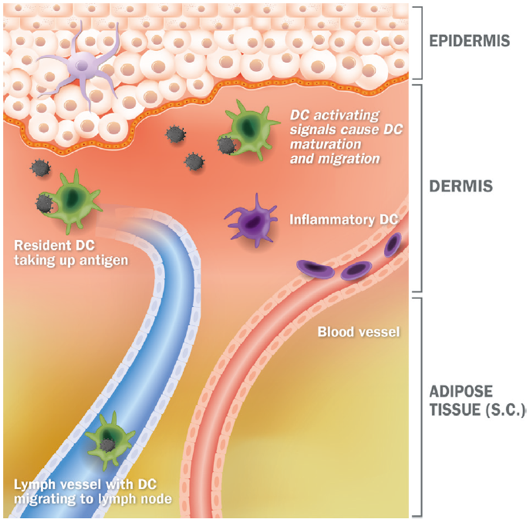
Figure 1. The dermis represents an excellent site for vaccine delivery, being rich in resident dendritic cells (DC), lymph vessels and blood capillaries.
Commercial modified live porcine reproductive and respiratory syndrome (PRRS) vaccines have been applied intradermally in pigs since 2003.
In this connection, there is already extensive experience with intradermal PRRS vaccination in those countries where the PRRS virus is endemic on pig farms.
Although there are many delivery systems that facilitate the intradermal application of vaccines, in pigs, needle-free jet injectors are, without doubt, the most widely used (Figure 2).
The intradermal application of vaccines with a needle-free injector involves the administration of a small volume of vaccine of around 0.2 ml.
The mechanism of needle-free jet injectors relies on the principle of forcing fluids through a small orifice, generating a high pressure stream that penetrates into the skin with a high velocity.
The impact of the fluid on the skin generates a hole through which the liquid is forced into the tissue without the help of a needle.
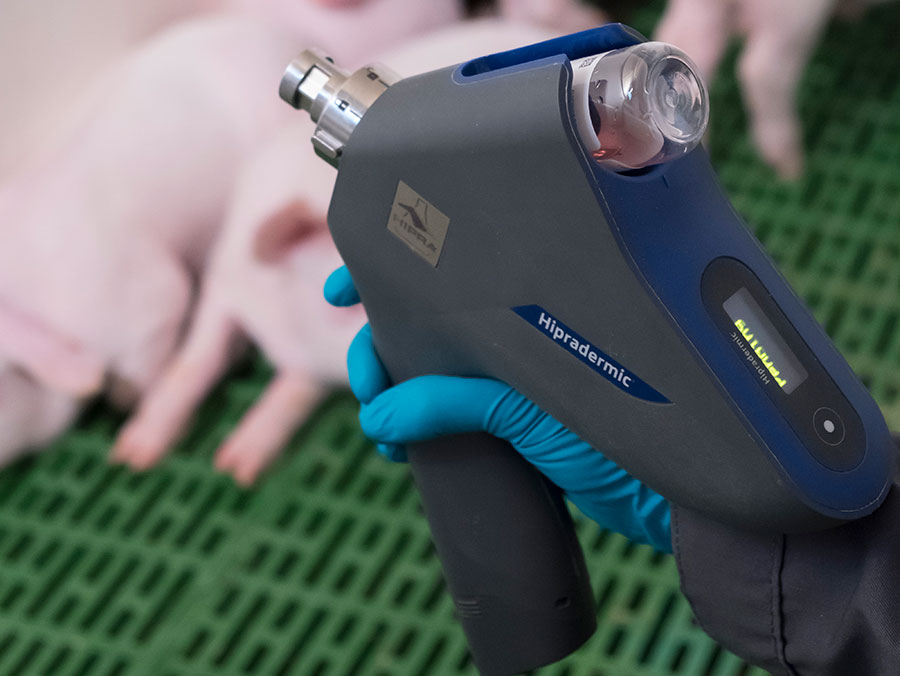 Figure 2. Hipradermic® needle-free jet injector for intradermal application of vaccines.
Figure 2. Hipradermic® needle-free jet injector for intradermal application of vaccines.
The consistent pressure profile of a needle-free jet injector ensures a homogenous process where each animal is vaccinated at the selected tissue depth.5
In addition, needle-free vaccination by intradermal injection has many advantages compared to other types of vaccination, especially with regard to the non-use of needles, such as:
- Elimination of the possibility of broken needles and damage to the carcass.
- Reduction of the risk of accidental needle stick injuries to employees.
- Reduction of the risk of spreading viraemic disease such as PRRSV, which occurs when re-using the same needle-syringe on multiple animals.
- Intradermal injection is also considered to be a less invasive technique, causing less stress and pain for the animals.
- Lowering the pain and stress of pigs in production has been shown to increase their general health and growth capabilities6.
Intradermal application of PRRS vaccines: Main benefits
Currently, all commercial MLV PRRS vaccines are indicated for intramuscular (IM) administration.
However, a few of them are also indicated for injection by the intradermal (ID) route.
Several studies have been specifically designed to compare immune responses and efficacy of PRRS vaccines between these two routes of administration.
Total antibodies measured by ELISA seem to be similar for both routes independently of the animal category (piglets and sows), although several trials have shown a trend towards the achievement of a higher level of antibodies with the intradermal route.7, 8
In the case of cell-mediated immune-response, intradermal administration can confer higher levels of cell-mediated response than the intramuscular route, as has been shown in different studies9 (see Figure 3).
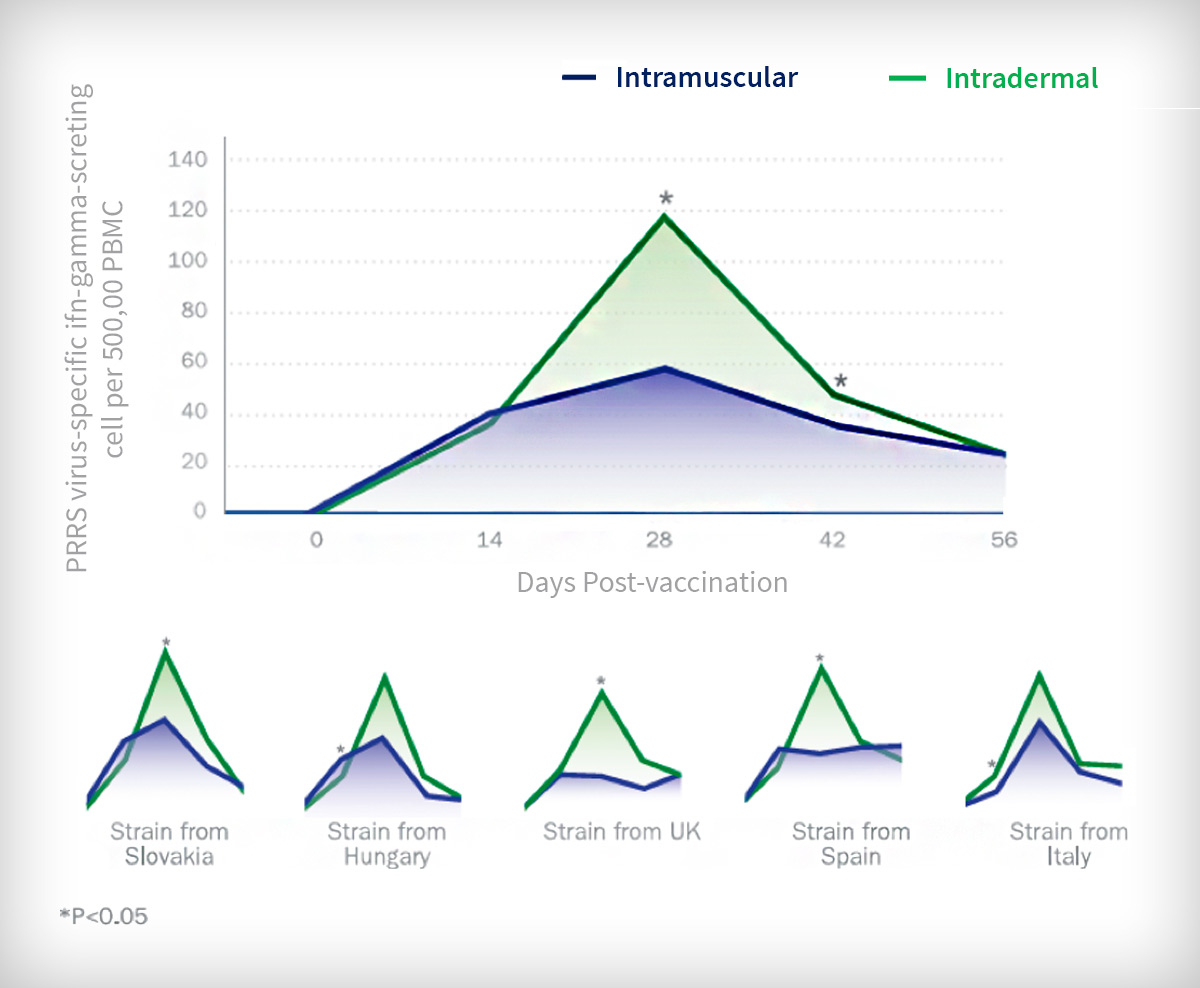
Figure 3. Comparison of intramuscular and intradermal administration in cell-mediated immunity against different field strains in UNISTRAIN® PRRS vaccinated gilts.
In the case of breeding females, different studies confirm that intradermal vaccination against PRRS (with UNISTRAIN® PRRS vaccine) using a needle-free device (Hipradermic®) enables the clearance of the virus by the mother and reduces its vertical and horizontal transmission to piglets after a heterologous wild-type PRRS infection during gestation10 (see Figure 4).
Figure 4. Comparison of duration of nasal shedding (left) and vertical transmission (right) after heterologous challenge in UNISTRAIN® PRRS intradermally vaccinated and non-vaccinated gilts. Different superscript letters indicate statistically significant differences (p<0.05) among groups.
A reduction in reproductive failure and improved piglet performance during lactation in terms of number and weight of weaned piglets has also been observed11 (see Figure 5).
Figure 5. Comparison of number (left) and weigh (right) of weaned piglets born from UNISTRAIN® PRRS intradermally vaccinated and non-vaccinated gilts. Different superscript letters indicate statistically significant differences (p<0.05) among groups.
With the results obtained in all these trials, although some studies have suggested differences between ID and IM administration in immune response, in terms of efficacy, when comparing both routes of administration by means of a challenge, no significant differences have been observed in any of the trials performed.
This, plus all the benefits mentioned before that come from needle-free administration of the vaccines, position intradermal vaccination as a practical solution for vaccination management on farms.
BIBLIOGRAPHY:
- 1. Miranda, J. et al.; June 2015. Vaccination with UNISTRAIN® PRRS in piglets reduces viraemia and excretion of PRRSV after a heterologous challenge with a Spanish strain. International PRRS Congress. Ghent, Belgium.
- 2. Linhares DC. et al.; 2014. Comparison of time to PRRSv-stability and production losses between two exposure programs to control PRRSv in sow herds. Prev Vet Med. 1;116(1-2):111-9. doi: 10.1016/j.prevetmed.2014.05.010
- 3. Busquet, M. et al.; June 2015. Efficacy of UNISTRAIN® PRRS administered intradermally in piglets in a multicentric field trial. International PRRS Congress. Ghent, Belgium.
- 4. E Kis, et al.; (2011). Devices for intradermal vaccination. Vaccine. 30. 523-38. 10.1016/j.vaccine.2011.11.020.
- 5. Chase, C. et al.; (2008). Needle-free injection technology in swine: Progress toward vaccine efficacy and pork quality. Journal of Swine Health and Production. 16.
- 6. Martinez Miró, S et al.; (2016). Causes, consequences and biomarkers of stress in swine: An update. BMC Veterinary Research. 12. 10.1186/s12917-016-0791-8.
- 7. Martelli, P et al.; (2007). Protection and immune response in pigs intradermally vaccinated against porcine reproductive and respiratory syndrome (PRRS) and subsequently exposed to a heterologous European (Italian cluster) field strain. Vaccine. 30; 25 (17):3400-8
- 8. Busquet, M et al.; (2016). Intradermal vaccination with UNISTRAIN® PRRS in a mass vaccination in sows. IPVS & ESPHM Congress.
- 9. Miranda, J et al.; (2015) Heterologous cell-mediated immune responses against PRRS virus in gilts vaccinated intramuscularly and intradermally with UNISTRAIN® PRRS. ISERPD Congress 2015.
- 10. Simón-Grifé, M.; (2018) Intradermal vaccination with UNISTRAIN® PRRS in gilts reduces viraemia and vertical/horizontal transmission after a heterologous challenge. ESPHM Congress.
- 11. Simón-Grifé, M.; (2018) Intradermal vaccination with UNISTRAIN® PRRS in gilts improves the performance of their offspring. ESPHM Congress.
HIPRA © All rights reserved

